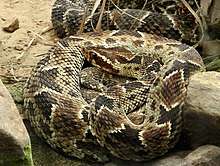Bothrops barnetti
Bothrops barnetti (Barnett's lancehead, Barnett's pit viper) is a venomous pit viper species endemic to Peru. No subspecies are currently recognized.[2]
| Bothrops barnetti | |
|---|---|
 | |
| Scientific classification | |
| Kingdom: | Animalia |
| Phylum: | Chordata |
| Class: | Reptilia |
| Order: | Squamata |
| Suborder: | Serpentes |
| Family: | Viperidae |
| Genus: | Bothrops |
| Species: | B. barnetti |
| Binomial name | |
| Bothrops barnetti Parker, 1938 | |
| Synonyms[1] | |
| |
Etymology
The specific name, barnetti, is in honor of Burgess Barnett (1888–1944), who collected the holotype and paratypes. Dr. Barnett was Curator of Reptiles at the London Zoo (1932–1937) and Superintendent of the Rangoon Zoological Gardens (1938–1944).[3]
Description
Bothrops barnetti is patterned in white and black triangles. Males usually grow to 120 cm (47 inches) in total length (including tail), whereas females are quite smaller and thinner. The body is heavily shaped and stocky.
Common names
English common names for B. barnetti are Barnett's lancehead[4] and Barnett's pit viper.[5] In Peru it is referred to as cascabel, cascabel falso, macanche, sancarranca, and zancarranca.[4]
Geographic range
Bothrops barnetti is found along the Pacific coast of northern Peru. It occurs at low elevations in arid, tropical scrub.
The type locality given is "from the mouths of Quebradas Honda and Perines, between Lobitos and Talara, northern Peru".[1]
References
- McDiarmid RW, Campbell JA, Touré T (1999). Snake Species of the World: A Taxonomic and Geographic Reference, Volume 1. Washington, District of Columbia: Herpetologists' League. 511 pp. ISBN 1-893777-00-6 (series). ISBN 1-893777-01-4 (volume).
- "Bothrops barnetti". Integrated Taxonomic Information System. Retrieved 5 November 2006.
- Beolens B, Watkins M, Grayson M (2011). The Eponym Dictionary of Reptiles. Baltimore: Johns Hopkins University Press. xiii + 296 pp. ISBN 978-1-4214-0135-5. (Bothrops barnetti, p. 17).
- Campbell JA, Lamar WW (2004). The Venomous Reptiles of the Western Hemisphere. Ithaca and London: Comstock Publishing Associates. 870 pp., 1,500 plates. ISBN 0-8014-4141-2.
- Brown JH (1973). Toxicology and Pharmacology of Venoms from Poisonous Snakes. Springfield, Illinois: Charles C. Thomas. 184 pp. LCCCN 73–229. ISBN 0-398-02808-7.
Further reading
- Parker HW (1938). "The vertical distribution of some reptiles and amphibians from southern Ecuador". Ann. Mag. Nat. Hist., Series 11, 2: 438–450. (Bothrops barnetti, new species, p. 447).
External links
- Bothrops barnetti at the Reptarium.cz Reptile Database. Accessed 6 December 2007.